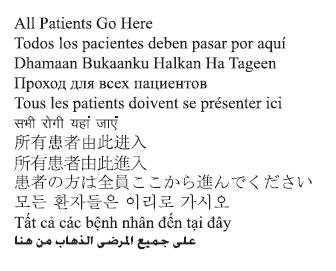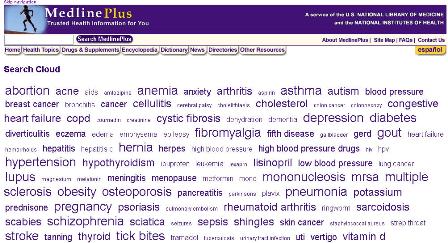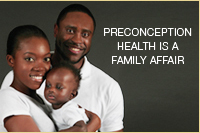This month AJN, American Journal of Nursing features a case study of a patient that proves this point. A severely disabled man received such poor oral care from nursing home personnel that his oral and nasopharyngeal secretions built up (?óÔé¼?ôinspissated?óÔé¼?Ø), and he died from asphyxia. The lead author, Joseph A. Prahlow, was the pathologist in charge of the autopsy; the article features graphic photos of the thickened secretions that blocked his airway. A companion article by two dentists, Pamela S. Stein and Robert G. Henry, gives nurses suggestions on how they can overcome barriers to providing oral care to patients.
Here is a link to other articles on the subject of oral hygiene of the elderly or patients in long term care.

Hospital sign: “All Patients Go Here” in multiple languages
An article from ACRL News pointed me to a new resource offering health information translations:
Health Information Translations
This resource, sponsored by several medical centers in Ohio, provides education and procedural instructions about health topics for patients with limited English proficiency. Search by keyword or language and retrieve a short document in English about that particular health issue followed by the translation of the article. Some documents have audio files. For example, the document on ?óÔé¼?ôbreast biopsy?óÔé¼?Ø explains the different kinds of biopsies, the procedure the physician will follow and instructions for the patient, all in Spanish. This is a source for timely, accurate medical vocabulary as well as practical application, since the translation of common procedures and instructions into Spanish is ready to be handed out to the patients. Includes translations of disaster preparedness plans. Access: http://www.healthinfotranslations.com/.
One of the best things I like about it are the common hospital signs with multiple translations (see photo above). The signs are available for download in PDF format for free on their site.
The city of New Orleans has been chosen as one of the 100 sites for the Healthy Start Program.
According to The Gambit’s Blog of New Orleans, “Healthy Start is a federally-funded initiative that was introduced in 1991 to lower the alarmingly high rate of infant mortality in the United States by addressing the disparity in prenatal care afforded women at different economic levels.”
Take the time to learn more about this great initiative providing prenatal and postnatal care to the women and children of our city.
The National Headache Foundation has declared that June 7-13, 2009 is National Headache Awareness Week.
Over 45 million Americans suffer from chronic, recurring headaches, with over half of these classified as migraines.
Headaches have numerous causes. Correctly diagnosing and treating a headache patient depends primarily on establishing an accurate and open line of communication.
The American Headache Society provides information on a variety of resources available to patients and medical professionals that are dedicated to the study and treatment of headache. Learn what you can do to help stop the pain.
Memorial Day is upon us again. And while it is the official start of summer in much of the US, it is most importantly a “day of remembrance for those who have died in our nation’s service.”
In honor of this day, here are a couple of interesting websites for the veterans or families of veterans:
MedlinePlus: Veterans & Military Health
Veterans History Project from the Library of Congress
National Institute of Allergy & Infectious Diseases (NIAID) provides Fact Sheets, Brochures, and Questions & Answers about HIV vaccine research and trials.
HIV Vaccine Researchers are working to develop a vaccine that is 100 percent effective and will protect everyone from HIV infections. HIV research is essential for Louisiana citizens. Look at the facts below.
HIV/AIDS in Louisiana FACTS
?óÔé¼?ó As of March 31, 2008 a cumulative total of 27,744 persons have been diagnosed with HIV/AIDS in Louisiana, including 302 cases in children under the age of 13.
?óÔé¼?ó There are persons living with HIV in every parish in Louisiana, and this number continues to increase each year, largely due to more effective drug therapies.
?óÔé¼?ó A total of 15,795 persons were known to be living with HIV/AIDS in Louisiana, of which 8,281 (52%) had been diagnosed with AIDS as of March 31, 2008.
?óÔé¼?ó In 2007, 1,152 new HIV cases were diagnosed in Louisiana; 30% of the cases were in Region 1 (New Orleans area) and 28% were in Region 2 (Baton Rouge area).
?óÔé¼?ó In 2007, 803 new AIDS cases were diagnosed in Louisiana. Of these cases, 33% occurred in Region 1 (New Orleans) ad 27% occurred in Region 2 (Baton Rouge).
?óÔé¼?ó In 2006, Louisiana ranked 5th highest in state AIDS case rates and 12th in the number of AIDS cases diagnosed in 2006.
?óÔé¼?ó Baton Rouge ranked 4th for AIDS case rates among the largest metropolitan areas in the U.S. in 2006; New Orleans ranked 8th.
?óÔé¼?ó In Louisiana, 30% of new HIV cases and 31% of new AIDS cases are among women.
?óÔé¼?ó HIV continues to disproportionately affect African Americans in Louisiana. In 2007, 72% of newly diagnosed HIV cases and 75% of newly diagnosed AIDS cases were among African Americans.
May is National High Blood Pressure Month and it’s a good time to get to know your numbers.
Blood pressure is the force of blood against the artery walls. It is stated as a set of two numbers, the top (systolic pressure) measures the force of your heart beating and the bottom (diastolic pressure) measures the relaxation between beats.
According to the National Heart, Lung and Blood Institute, a high blood pressure diagnosis results when you have repeated readings of 140 over 90. Pre-hypertension is the term given to readings from 120 to 139 over 80-89.
High blood pressure is considered a “silent killer” because often there are no symptoms at first. Through time, uncontrolled high blood pressure can lead to stroke, heart attack, heart failure, or kidney failure.
More than 72 million American adults, 1 in 3, have high blood pressure. Although certain risk factors, such as age or family history, can’t be controlled, we can make lifestyle changes to help maintain a healthy blood pressure.
Get yourself checked. Learn your numbers now.
In a long list of health observances, May brings you “Better Sleep Month.”
This awareness comes at a perfect time; as the days get longer and hotter, and people make time for well-deserved rest and relaxation.
Getting the right amount of sleep is just as important as a healthy diet and exercise. However, factors like stress and sleep illnesses can interrupt a satisfactory night’s rest.
Visit The Better Sleep Council to learn interesting sleep statistics, common sleep problems and to discover the interesting history of our wonderful friend, The Bed.

This year the 10th annual National Women?óÔé¼Ôäós Health Week kicks off today!?é?á It is a weeklong health observance coordinated by the U.S. Department of Health and Human Services?óÔé¼Ôäó Office on Women?óÔé¼Ôäós Health (OWH). This year?óÔé¼Ôäós theme is ?óÔé¼?ôIt?óÔé¼Ôäós Your Time?óÔé¼?Ø.

Some tips to increase physical and mental health include:
Locally there are a few events that are taking place:
Taking it to the Streets ?óÔé¼ÔÇ£ A City Walk and Lunch promoting women?óÔé¼Ôäós mental and physical health (http://www.tulane.edu/~tuxcoe/NewWebsite/com_womens_health/index.html)
Ask your Health Provider ?óÔé¼ÔÇ£ Clinical screening & exam, HIV & STI treatment and/or prevention, Taking the Pledge! (http://www.dhh.louisiana.gov/offices/?ID=264)
So far, Louisiana only has 6 women who took the pledge and is trailing far behind Missouri which has 155 pledges, so take the pledge today!
One week, not enough?
If you?óÔé¼Ôäód like to continue the Woman Challenge there is an eight-week online activity program that allows you to track your progress, so sign up today!

For more information please visit http://www.womenshealth.gov/whw/ .
Earlier today, two LSUHSC physicians were featured in a Live Chat on NOLA.com regarding Swine Flu. Fred Lopez & James Aiken answered questions from participants for about an hour starting at 12 noon.
Louisiana is clear for the moment, but human cases of swine influenza A (H1N1) virus infection have been identified in the United States. The Centers for Disease Control have created a Swine Influenza (Flu) page at http://www.cdc.gov/swineflu/index.htm
It includes incidence of U.S. Swine Flu Infection, currently at 20 cases in California, Kansas, Ohio, Texas and New York City.
More from CDC:
Interim CDC Guidance for Nonpharmaceutical Community Mitigation in Response to Human Infections with Swine Influenza (H1N1) Virus: http://www.cdc.gov/swineflu/mitigation.htm
Guidance for Clinicians & Public Health Professionals: http://www.cdc.gov/swineflu/guidance/
For international information & global statistics, see the the World Health Organization’s Swine flu page:
http://www.who.int/csr/disease/swineflu/en/index.html
For folks in Louisiana, the State Dept. of Health and Hospitals encourages “Aggressive Prevention” Against Swine Flu:
http://wwwprd.doa.louisiana.gov/LaNews/PublicPages/Dsp_PressRelease_Display.cfm?PressReleaseID=2019&Rec_ID=0
The White House also issued a press briefing on Swine Influenza:
http://www.whitehouse.gov/the_press_office/Press-Briefing-On-Swine-Influenza-4/26/09/

http://www.nlm.nih.gov/medlineplus/cloud.html
It just got a little easier to find out what consumer health topics are currently popular with patients. MedlinePlus, your number one authority from the NIH on patient health, just released a search cloud.
The search terms appear in alphabetical order, and their size represents their relative frequency. The bigger the term, the more often it is searched by people who visit MedlinePlus. A term’s exact ranking is found by placing your cursor over the term, and you can click on any term in the search cloud to conduct a search for that term in MedlinePlus.
Anyone who’s been on a camping trip lately can sympathize with why tick bites are so popular right now.
As part of National Environmental Education Week and Earth Day, the National Library of Medicine is promoting its toxicology resources. These resources include: ToxMAP, ToxTown, ToxMystery, MedlinePlus, Household Products Database, and Hazardous Substances Data Bank (HSDB). Several of these resources are part of TOXNET which provides access a host of information related to toxicology, hazardous chemicals, and environmental health. For more information on Environmental Health and Toxicology, check out the Special Information Services page at NLM.
April is indeed a busy month, adding?é?áAlcohol Awareness Month?é?áto the list?é?áof health observences.
Drinking one glass of wine per day has been clinically proven to provide health benefits. But what are the risks of drinking more than one glass on the weekend?
Brush up on facts about alcohol to help keep you and your loved ones safe.
Also, learn where Louisiana stands in drunk driving statistics.

April is a popular month for health observances, including National Minority Health Awareness Month sponsored by the US Department of Health and Hospitals Office of Minority Health. Preconception is the theme for 2009 with the slogan “Ordinary couples don?óÔé¼Ôäót plan their pregnancies. Be extraordinary!”

National Minority Health Month

 myLSUHSC
myLSUHSC





